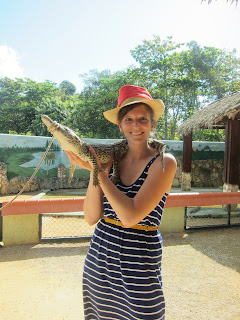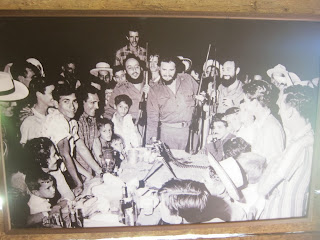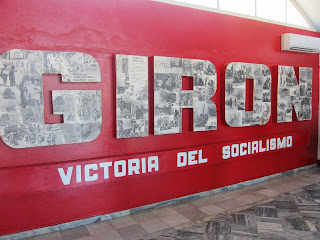For my second day in Cuba I signed up for a SAS trip to the Bay of Pigs. I figured it would give me the chance to see some other parts of Cuba, visit a very important historical site, and hear about the
Bay of Pigs Invasion from the Cuban perspective. The trip also involved an excursion to the Zapata Biosphere (basically, the mangrove swamps near the Bay). We stopped there first, and took little motor boats to an island in the middle of the swamp.
At first I didn't really understand the connection of the biosphere to the Bay of Pigs invasion, but it turns out it is pretty important. The reason that the American-funded Cuban exiles decided to invade at that specific location was because it was not at all developed, was sparsely populated, was far enough from Havana that they figured there wouldn't be too much support for the government, and the landscape would make it easy to hide.
We also went to a crocodile preserve. I of course did some posing with a baby crocodile.
 |
| Unlike the Amazonian alligator, this guy's mouth is tied shut. But don't worry, the trainer really loved him and they rotate out the crocs every 30 minutes or so to make sure they aren't overexposed. |
 |
| The trainer also lent me his hat. |
Then I got the chance to feed the big crocodiles. You put some meat on a string attached to a pole, then you're supposed to tease the crocs by putting it near them and then jerking it away when they snap. It was a lot harder than you might think!
Our next stop was a small town populated by charcoal-makers. We drove for about 30 minutes down a rutted, narrow road - oftentimes I wasn't sure the bus was going to make it through! The bus driver didn't seem sure either and he certainly wasn't happy about the abuse his bus was taking. It turns out that this tiny town was where Fidel spent the first Christmas Eve after the Revolution. He and his men had been working near by, and decided to find a place to eat dinner. They picked this town and sent for tons of food and supplies. Then Fidel "came down in his helicopter, like a star falling from the heavens" and ate with them in their huts. The spot now has a small museum. It was definitely the most pro-revolutionary moment of the trip.
 |
| Thanks, Fidel! |
 |
| Charcoal-makers' huts. |
 |
| A gun-toting Fidel enjoys Christmas Eve supper. |
This also plays into the Bay of Pigs story. As I mentioned, the exiles decided to invade at the Bay of Pigs because it was remote, mostly uninhabited, and not likely to have many ties to the regime. However, ever since this first Christmas Fidel had adopted the region as a sort of pet project and worked hard to better living conditions for the charcoal makers. So instead of a few apathetic peasants, the exiles met with people very loyal to Fidel.

After a break for lunch we finally headed to the Bay of Pigs proper, or Playa Giron (Giron Beach) as the Cubans call it. While they do refer to the physical bay as the "Bahia de Cochinos," when referring to the events of April 1961 they always talk about Playa Giron. We didn't have much time, but we visited a small museum where we saw artifacts from the invasion - just about everything pulled off of any of the fighters, including their house keys and underwear. We also watched a film reel from 1961 that was made in Cuba and told their perspective. It seemed like our guides were afraid it would upset us, as it spoke of "yanqui imperialism" and "mercenaries," but I thought it was actually fairly balanced, especially compared to the US anti-communism propaganda of the era. Have you seen
The Atomic Cafe? The Cuban newsreel was tame compared to that. All and all they day was a really interesting look at a touchstone event of the last 50 years.
 |
| Giron Museum |
 |
| Giron: Victory of Socialism |











No comments:
Post a Comment